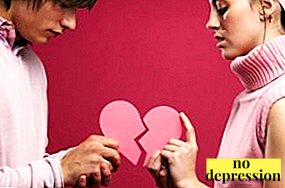Alcohol withdrawal syndrome is a pathological condition that occurs when a person who has strong addictiontrying to refuse to accept ethanol-containing beverages.
The severity and general set of symptoms characteristic of the syndrome depends on the stage of alcoholism, the age of the patient and other factors.
The stopping of alcohol withdrawal, proceeding hard, carried out in the hospital.
What is withdrawal syndrome?

Alcoholism - Persistent dependence of a person on the intake of alcoholic beverages and alcohol-containing liquids (experienced alcoholics who do not have enough money for full-fledged alcohol, replace it with pharmaceutical alcohol tinctures and colognes).
Often, dependency in men and women is formed against the background of mental illness (depression, neurosis), problems in life.
A person gets used to pouring in small and big troubles with alcohol-containing drinks and eventually ceases to be able to refuse them.
Since alcohol is a depressant, most alcoholics have post-alcohol depression, which encourages them to drink more.
Alcohol withdrawal syndrome - Another pathological condition that affects a person's desire to drink.
In terms of its characteristics, it resembles a hangover, but is much more severe, and if a person does not drink, it will persist for several days. The usual hangover takes place in a few hours, even without medication.
Alcohol withdrawal observed in the second and third stage of alcoholism. This state is characterized by the presence of an extremely strong, painful desire to drink, which increases in the evening against the background of exacerbation of psycho-emotional symptoms - anxiety, sadness.
The longer the experience of an alcoholic, the harder it is abstinence. The mildest variant of the withdrawal syndrome is observed during the transition from the first to the second stage of alcoholism, the most severe, requiring hospitalization, - on third.
Causes

The only reason for the appearance of withdrawal is persistent dependence on ethanol-containing beverageslasting at least two to three years.
If we talk about physiological processes, the mechanism of the emergence of withdrawal syndrome can be represented as the following chain:
- Due to prolonged alcohol intake the process of splitting the alcohol-containing beverages entering the body varies. Products entering the gastrointestinal tract undergo a fermentation process. In healthy people, alcohol-containing fluids processes the enzyme alcohol dehydrogenase.
But, if these liquids come in a large amount for a long time, the body activates other processing methods that use the microscopic ethanol-acidizing system and the enzyme catalase. And the level of alcohol dehydrogenase decreases.
- Due to changes in fermentation processes the blood level of acetaldehyde begins to rise - the product of ethanol oxidationadversely affecting dopamine concentration.
- Due to lack of dopamine in alcoholic steady dependence on alcohol is formedbecause it replaces dopamine for a while. This happens in the first stage.
- When alcoholism goes to the second stage, the absence of alcohol leads to a violation of the compensatory mechanismin which it replaces dopamine, as a result, the body begins to actively produce this neurotransmitter.
- Due to the sharp jump in dopamine concentration symptoms typical of withdrawal symptoms develop. The higher the dopamine level, the more pronounced the symptoms. If the concentration of this neurotransmitter exceeds the norm three or more times, delirium develops (it is also called delirium tremens).
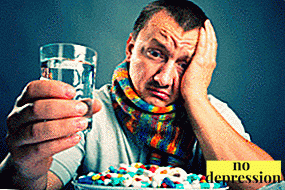
In addition, acetaldehyde has negative effect on the oxygen concentration in the blood.
Accordingly, the tissues of the body begin to receive less of it, which leads to the appearance of additional symptoms observed during abstinence.
Classification and symptoms
The main types of syndrome, depending on the key symptoms:
- Somatic. In this case, violations in the functioning of the internal organs and systems, mainly on the part of the gastrointestinal tract, were most pronounced. The patient has moderate yellowing of the eye proteins, arrhythmia, increased flatulence, nausea, vomiting, diarrhea, pain in the heart and upper abdomen.
- Neurovegetative. Of all the types found most often. Accompanied by problems with sleep (insomnia, frequent waking, painful, anxious dreams), loss of appetite, up to its disappearance, accelerated pulse, swelling of the face, dry oral mucosa, irregular blood pressure, tremor of the hands, excessive sweating.
- Psychopathological. At the core of this form are mental abnormalities: anxiety, occasionally aggravated, especially in the evening, severe sleep problems, short illusions, and even hallucinations. Spatial orientation is broken. Patients with a psychopathological form are prone to suicidal behavior.
- Cerebral. This species is characterized by loss of consciousness, severe pain in the head, dizziness, hypersensitivity to sound stimuli, and in some cases seizures.
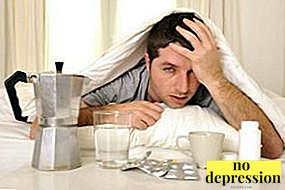
Psychiatric disorders are present in abstinence always, in any of the course options, but their severity varies from mild to severe.
Three severity of withdrawal symptoms are also distinguished:
- The first. It is observed between the first and second stage of alcohol dependence. Appears after two or three days or more of alcohol. The most prominent signs are severe dryness in the mouth, excessive sweating, rapid heartbeat, weakness, and a feeling of fatigue. Mild anxiety and other mental abnormalities may also appear.
- The second. When the patient has a steady second stage of alcoholism, symptoms associated with withdrawal symptoms will worsen, new ones will appear. As in the past case, it develops after a binge. By the above symptoms are added signs that indicate the incorrect functioning of the internal organs: the sclera and skin redden, blood pressure fluctuates, vomiting, nausea, hand tremor, staggering while walking, difficulty in trying to maintain balance are observed.
- Third. Present between the second and third stages, observed after a long binge (at least a week). Symptoms characteristic of previous degrees of severity are present, but psycho-emotional abnormalities become the most pronounced. Patients see frightening dreams, they have various sleep disorders (insomnia, frequent waking, daytime sleepiness), frequent anxiety, anxiety, guilt, sadness, hopelessness, increased aggressiveness is possible. At the third stage, there are both somatic and mental symptoms, and their severity increases.
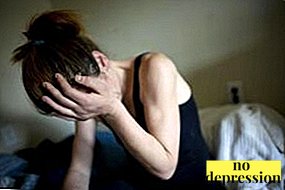
But, one way or another, the set and severity of symptoms varies and depends on many factors: age, state of somatic health, the presence of mental illness, the length of binge and the drinks that were consumed.
In addition, in the course of the withdrawal syndrome, two separate stages can be distinguished:
- Early symptoms. Appears during the first two days after the failure of ethanol-containing liquids. Accompanied by somatic and mental disorders.
- Late symptoms. The second wave of symptoms is observed on the second to fourth day after failure. In this case psycho-emotional disorders, up to delirium, hallucinations come to the fore. Some of the symptoms observed earlier are aggravated. It is during this period that delirium may occur.
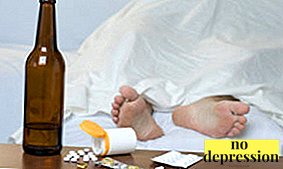
In rare cases, the first sign of abstinence becomes epipristup, and other symptoms occur later.
Treatment
Tactics cupping withdrawal syndrome in each individual case is determined individually, depending on the age and health of the patient, as well as a set of symptoms.
In the presence of severe psycho-emotional disorders, the treatment process takes place within a psychiatric hospital.
Treatment can take place at home only in case of a mild course.in which nothing threatens the life and health of the patient and those around him. It is important that the patient was examined by a doctor who determines the tactics of treatment.
Required items hospital treatment are:
- connecting droppers with saline, eliminating and preventing dehydration;
- the introduction of vitamins;
- carrying out activities aimed at the removal of toxic substances from the body (in mild cases, it is enough to take Smekta or other enterosorbents inside, with severe plasmapheresis can be indicated);
- the introduction of medications that improve the condition of those internal organs that require attention, especially if the patient has chronic diseases;
- the introduction of drugs that improve the psycho-emotional state of the patient.
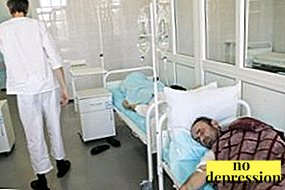
Carrying out all these activities at the proper level ensures quick relief of withdrawal symptoms.
It treats this pathological condition expert in narcology.
Groups of medicines often used in the treatment of abstinence:
- Enterosorbents (Smecta, Polisorb). Accelerate the excretion of toxic substances.
- Anticonvulsants (Carbamazepine). Prevent the occurrence of epileptic seizures, are appointed on a mandatory basis in cases where the patient had seizures.
- Benzodiazepines (Phenazepam, Diazepam). Eliminate anxiety, have a positive effect on sleep, reduce the likelihood of epileptic seizures.
- Antipsychotics (Haloperidol, risperidone). Appointed if the patient has hallucinations, delusions, he behaves aggressively.
But with some severe delirium, it may be contraindicated.
- Sleeping pills (often from the group of barbiturates: Cyclobarbital, Thiopental). Shown in the presence of pronounced sleep disorders.
- Diuretics (Veroshpiron, Furosemide). Reduce pressure, accelerate the elimination of toxic substances.
Medical scheme selected by doctors, based on the available data.
First aid at home
If your loved one who suffers from alcoholism has any signs of alcohol withdrawal, it is important:
- If possible, constantly give the patient to drink plenty of water or (which is the best option) oral rehydration solution. This is especially necessary if a patient has vomiting and diarrhea, because during these processes water and minerals leave the body actively, which is fraught with the development of dehydration. If benzondiazepines were prescribed to him or other means to improve the psycho-emotional state, it is important to give them. If it is difficult or impossible to water the patient for any reason, it is necessary to call an ambulance.
- Determine the severity of his condition. Recall whether he has chronic diseases, measure the pressure, look for documentation that a doctor may need.
- Call a narcologist at home (if the condition of the patient is critical, then an ambulance). An emergency call is necessary if a person has severe diseases of the liver, heart, kidneys, pancreas, acute respiratory diseases (bronchitis, pneumonia), if he shows aggression and is dangerous for himself and others, threatens to commit suicide, hallucinate, bears rave.

But to determine whether it is advisable to carry out treatment at home, must doctor. He will also prescribe the necessary medications, explain what kind of diet you need to follow, and so on.
With abstinence, it is unacceptable to ignore the need for an inspection: that which may seem insignificant to a non-professional can actually pose a threat.
In addition, the patient’s condition is heterogeneous, and after the first symptomatic wave subsides, the second will follow, in which even possible appearance of delirium (delirium tremens).
Prognosis and prevention

With mild withdrawal syndrome symptoms subside within ten daysif the treatment was not carried out.
If therapy is present, it is twice as fast.
The prognosis for more severe depends on many factors: age, mental and physical health, a set of symptoms, and so on.
If the patient continues to consume alcohol, his condition will inevitably worsen, and each subsequent case of withdrawal syndrome will be heavier than the previous one.
Prevention of abstinence consists directly in the prevention of alcoholism: to completely eliminate the likelihood of this pathological condition, it is important to abandon the use of ethanol-containing beverages.
Alcohol treatment process complicatedIt requires the involvement of various specialists, including psychologists and psychotherapists.
Alcohol withdrawal syndrome:



